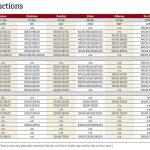Glacier FarmMedia -– Canola futures on the Intercontinental Exchange corrected themselves on Wednesday after the November contract dropped below C$600/tonne for a brief period. Stronger soybean and vegetable oil prices underpinned gains.
An analyst said the slow pace of exports and the ongoing canola harvest are pressuring prices. Another analyst said the contract might test March lows at around C$580/tonne. Both of them doubt the United States and China will come to an agreement on Chinese soybean imports in the next few weeks.
Read Also
Canadian Financial Close: C$ weakens Wednesday
Glacier FarmMedia — The Canadian dollar was weaker relative to its United States counterpart on Wednesday, with a slowdown in…
Chicago soyoil, European rapeseed and Malaysian palm oil were higher. Crude oil was lower due to demand concerns and plans by OPEC+ to raise output next month.
At mid-afternoon, the Canadian dollar was down one-tenth of a U.S. cent compared to Monday’s close. There was no posted exchange rate nor canola trading on Tuesday due to the National Day for Truth and Reconciliation.
There were 71,991 canola contracts traded on Wednesday, compared to Monday when 49,655 contracts changed hands. Spreading accounted for 39,390 of the contracts traded.
SOYBEANS on the Chicago Board of Trade had their biggest one-day gain since Sept. 12. During the session, November soybeans fell below US$10 per bushel for the first time since Aug. 25. Before trading at a range of more than 26 cents/bu.
Over the next week, much of the United States will see warm and dry conditions, which will help advance harvests.
The United States Department of Agriculture reported on Monday that 62 per cent of the soybean crop was rated good to excellent as of Sept. 29, up one point from the previous week. Soybeans in Kansas and Tennessee declined five points, while those in Michigan and Missouri improved four points.
The U.S. soybean harvest advanced 10 points at 19 per cent complete, five points behind last year and one point above the five-year average. The percentage of soybeans dropping leaves was 79 per cent, same as last year but two points above the five-year average.
Crop consultant Dr. Michael Cordonnier left his soybean yield estimate unchanged at 52 bushels per acre.
Analysts estimated the August U.S. soybean crush to total 196.4 million bushels. The USDA’s Fats and Oils report was set to be released today, but is now delayed due to the U.S. government shutdown.
The Buenos Aires Grain Exchange said Argentine soybean production was estimated at 48.5 million tonnes for 2025/26, down 1.8 million from last year.
ANEC reported Brazilian soybean exports were estimated at 7.13 million tonnes for September.
December CORN fell to its lowest price since Aug. 28 on Wednesday, but recovered to make a small gain at the end of trading.
U.S. corn was unchanged at 66 per cent good to excellent while 18 per cent of the harvest was complete, up seven points from last week and one point below the five-year average. The crop was 95 per cent dented, down one point from the average, as well as 71 per cent mature, three points below average.
Cordonnier left his corn yield estimate unchanged at 182 bu./ac., adding that early yields look “disappointing”.
The U.S. Energy Information Administration reported average daily ethanol production at 995,000 barrels per day for the week ended Sept. 26, down 29,000 bpd from the previous week. Ethanol stocks were down 704,000 barrels at 22.764 million.
The BAGE estimated the Argentine corn crop at 58 million tonnes, well above the 49 million from last year.
ANEC projected Brazilian corn exports for September at 7.27 million tonnes, which was a drop of 340,000 from the estimate last week.
Chicago soft WHEAT showed minimal gains, while Kansas City hard red and Minneapolis spring were in negative territory.
Winter wheat planting in the U.S. advanced 14 points at 34 per cent, three points behind a year ago and two points behind the five-year average. Emergence was at 13 per cent, same as one year ago but one point ahead of the average.
Taiwan issued a tender for 80,550 tonnes of U.S. wheat with the deadline set for Thursday.
The BAGE estimated the Argentine wheat crop to be 22 million tonnes, up 1.5 million from the previous estimate.
Wheat exports from the European Union since July 1 totaled 4.37 million tonnes, down from 6.36 million one year ago.










